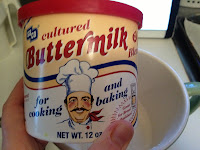One of my husband’s fondest memories is his beloved Abruzzesse aunt and grandmother making mazza fame. I had never heard of it before I met him – it was told to me that it meant “kill hunger.” (My best guess is that it comes from the Italian verb ammazzare.)
Although the Sicilians also have a fried pizza, I have never heard of mazza fame anywhere else. But the joys of fried dough are universal and decided to revisit it when my own kids suddenly got very picky at dinnertime.
The pizza dough I like best is Guy Fieri’s and I've tried a bunch of them. It is not a brilliant recipe – there is no semolina or fancy rises. But it works and works well. Rises great. You can use all purpose crap flour. Important, considering I have to double it to work in this house.
One thing, you will use a LOT of yeast. Those little envelopes only hold about one teaspoon and a half. Go invest in a jar of yeast for the fridge. And before you make the dough, you had better make sure that yeast proofs.
Mix it up with the dough hook attachment, place it in a lightly oiled bowl and cover with plastic wrap. Leave it for an hour or so in the warmest place in the house. I usually put it upstairs in one of our bedrooms.

And then voila! Look at that nice rise.

Diced pancetta is one of my favorite secret ingredients, found in the packaged cold cut section of ShopRite. They sell diced pancetta and prosciutto. I keep them in my freezer so I can always throw in a few tablespoons. (My go-to easy pasta sauce is this stuff, onions, garlic nicely sautéed and brown, throw in some frozen peas and shit-ton of black pepper.) My second favorite ingredient (which is easily added to everything) is vermouth. Get a good bottle of white vermouth (I prefer NoillyPrat) and with a 3:1 ratio of vermouth to water – you have a ready-to-use wine substitute for cooking. Won’t go bad and always at the ready.
Anyhoo, after everything browns nicely, add a can of tomatoes and let that cook down into oblivion. No little cans of tomato paste. Never. Unless you want to everything to taste like tin and bullshit.
FYI, this is not The Sauce. This is a quickie. The Sauce is a full scale eight hour ragu and requires many different frightening animal parts. I’ll cover that in a future post.
So our dough is ready, our pastry board is out and let’s roll. This is a super sticky dough, you will need lots of additional flour.
Here are the two things to remember: roll it THIN and put them into an inch or so of oil that has to be CRAZY HOT. Hotter than you think. I actually put in my candy thermometer into the oil and things starting getting good over 350 degrees. Which is why I use canola, because of the higher flashpoint. And you'll want a saucepan with deep sides, this stuff is dangerous.
My rounds are about 6-7" diameter and should PUFF and bubble when they hit the oil.
You flip that over and continue until they are all lovely and golden. Set them on paper towels and sprinkle with sea salt.
You flip that over and continue until they are all lovely and golden. Set them on paper towels and sprinkle with sea salt.









